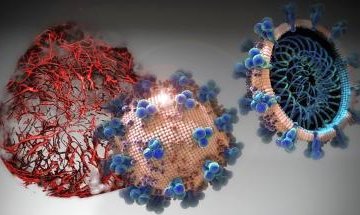A new trial drug dramatically blocks the COVID-19 coronavirus load by 1,000 to 5,000 times in human organoids. The drug is called hrsACE2 (human recombinant soluble angiotensin-converting enzyme 2). Organoids are three dimensional replicas of cells in culture. The finding was made by researchers at the University of British Columbia and is published in the journal Cell.
Drug Blocks Coronavirus Infection
The finding is promising, as hrsACE2 seems to be able to block SARS-CoV-2, the virus that causes COVID-19, and stop early infection of COVID-19 in blood vessels and kidneys organoids. This discovery may lead to the development of a novel drug to treat the current pandemic of COVID-19. As of April, 3, 2020, over one million people globally have been infected and over 58,000 people have died from the pandemic.
ACE2 Receptor as a Target
ACE2 is a protein on the surface of the cell membrane. It is the receptor that binds to the spike glycoprotein of SARS-CoV-2. In other words, the coronavirus binds to cells through ACE2. It was shown that ACE2 is also the receptor for SARS, the viral respiratory illness that became an epidemic in 2003.
“Our new study provides very much needed direct evidence that a drug — called APN01 (human recombinant soluble angiotensin-converting enzyme 2 – hrsACE2) — soon to be tested in clinical trials by the European biotech company Apeiron Biologics, is useful as an antiviral therapy for COVID-19,” said Art Slutsky, one of the researchers.
Inhibited Virus Up to 1000 to 5000 Times
The researcher found that hrsACE2 inhibited the coronavirus load by a factor of 1,000-5,000 in human blood vessel and kidneys organoids. The researchers demonstrated that the virus can directly infect and duplicate itself in these organoid tissues. When clinical grade hrsACE2 were given to these organoids, the SARS-CoV-2 infections were reduced.
“Using organoids allows us to test in a very agile way treatments that are already being used for other diseases, or that are close to being validated. In these moments in which time is short, human organoids save the time that we would spend to test a new drug in the human setting,” said Núria Montserrat, another of the researchers.
Hope for Pandemic
“The virus causing COVID-19 is a close sibling to the first SARS virus,” said Josef Penninger, the study team leader.
“Our previous work has helped to rapidly identify ACE2 as the entry gate for SARS-CoV-2, which explains a lot about the disease. Now we know that a soluble form of ACE2 that catches the virus away, could be indeed a very rational therapy that specifically targets the gate the virus must take to infect us. There is hope for this horrible pandemic,” he said.

